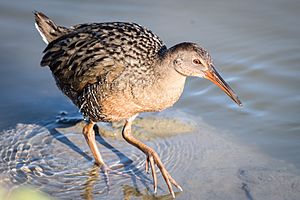Ridgway's rail facts for kids
Quick facts for kids Ridgway's rail |
|
|---|---|
 |
|
| Conservation status | |
| Scientific classification | |
| Genus: |
Rallus
|
| Species: |
obsoletus
|
| Synonyms | |
|
Rallus longirostris obsoletus |
|
The Ridgway's rail (Rallus obsoletus) is a bird that is considered near-threatened. This means its numbers are low and it could become endangered. You can mostly find this bird in California, from the San Francisco Bay down to southern Baja California. It belongs to the rail family, called Rallidae. This bird is about the size of a chicken and usually does not fly much.
The Ridgway's rail is very similar to the clapper rail. In fact, for a long time, people thought it was just a type of clapper rail. This bird has a long bill that curves downwards. Its body is grayish-brown, with a light chestnut-colored chest and a clear whitish patch on its rear. Sadly, there are not many Ridgway's rails left. This is because their homes, which are coastal and marshy areas, have been destroyed by building and filling in land. These birds are active all day and night, following a daily cycle. They are most vocal and noisy during the night and at dawn or dusk.
Contents
Where Does the Ridgway's Rail Live?
The Ridgway's rail looks for food in specific places. It likes the edges of mudflats and areas with taller plants. It also feeds in tidal sloughs, which are muddy channels. Its favorite foods include Mussels, clams, arthropods (like insects), snails, worms, and small fish. It finds these foods by poking its bill into the mud or picking things off the surface while walking.
This bird only hunts for food on mudflats or in very shallow water. It needs to be close to tall plants. These plants offer protection when the tide is high. During high tides, it might also eat mice or even dead fish it finds.
Important Homes for Ridgway's Rails
One of the biggest groups of Ridgway's rails lives in the San Francisco Bay area. About 1,100 of these birds live there. The picture above shows a Ridgway's rail near the Dumbarton Bridge. The Don Edwards San Francisco Bay National Wildlife Refuge in this area helps protect the homes of these birds and other local animals.
You can often spot Ridgway's rails in other parts of the San Francisco Bay. These places include the Napa Sonoma Marsh, Bothin Marsh in Mill Valley, and Gallinas Creek in San Rafael. They are also seen at Arrowhead Marsh and Damon Marsh in Oakland. Other spots are the Palo Alto baylands, Charleston Slough in Mountain View, Seal Slough in San Mateo, and Belmont Slough.
What Plants Do They Need?
For safety and hiding, Ridgway's rails prefer wetland areas. These areas are usually full of plants like pickleweed and cordgrass. They also like brackish wetlands, which have a mix of fresh and salt water. In these areas, they find pickleweed, cordgrass, and bulrush plants. It is not clear if they need a source of fresh water.
These birds do not migrate from their coastal wetland homes. However, young birds do move into freshwater wetlands from late August to October. Ridgway's rails have been seen looking for food even in areas that are a bit disturbed. This shows how important it is to protect even small marsh areas. For example, one was seen feeding in a small mudflat in Seal Slough in San Mateo. This was three miles from where they are known to breed in Belmont.
Life Cycle and Breeding
Ridgway's rails in the San Francisco Bay area breed from mid-March through August. Their busiest time for breeding is in late June. During this breeding season, you might find about 0.1 to 0.6 birds per acre. Outside of breeding season, the numbers drop to 0.04 to 0.40 birds per acre.
The nest is made of twigs and is placed low, sometimes among plant roots. The eggs are buff-colored with purple spots. A female bird lays a group of eggs called a clutch. This clutch can have four to fourteen eggs, but usually has about 7.6 eggs. The eggs take about 18 to 29 days to hatch. About 38% of the eggs successfully hatch. This is less than the light-footed rail, which lives in southern California and is similar.
Different Types of Ridgway's Rail
There are a few different types, or subspecies, of Ridgway's rail:
- Rallus o. obsoletus: This is the main type, once called the California clapper rail.
- Ridgway's Rail: This bird was officially named by James Maley after the famous bird expert Robert Ridgway.
- Rallus o. levipes: This type is called the light-footed rail. It is an endangered species in the U.S. and California. It lives from Santa Barbara County down to the northern coast of Mexico on the Pacific Ocean.
- Rallus o. yumanensis: This type is called the Yuma rail. It lives in southeastern California, southern Arizona, and northwestern Mexico.
- Rallus o. beldingi: This type is called Belding's rail. It lives in southern Baja California.
See also
 In Spanish: Rascón de Ridgway para niños
In Spanish: Rascón de Ridgway para niños



